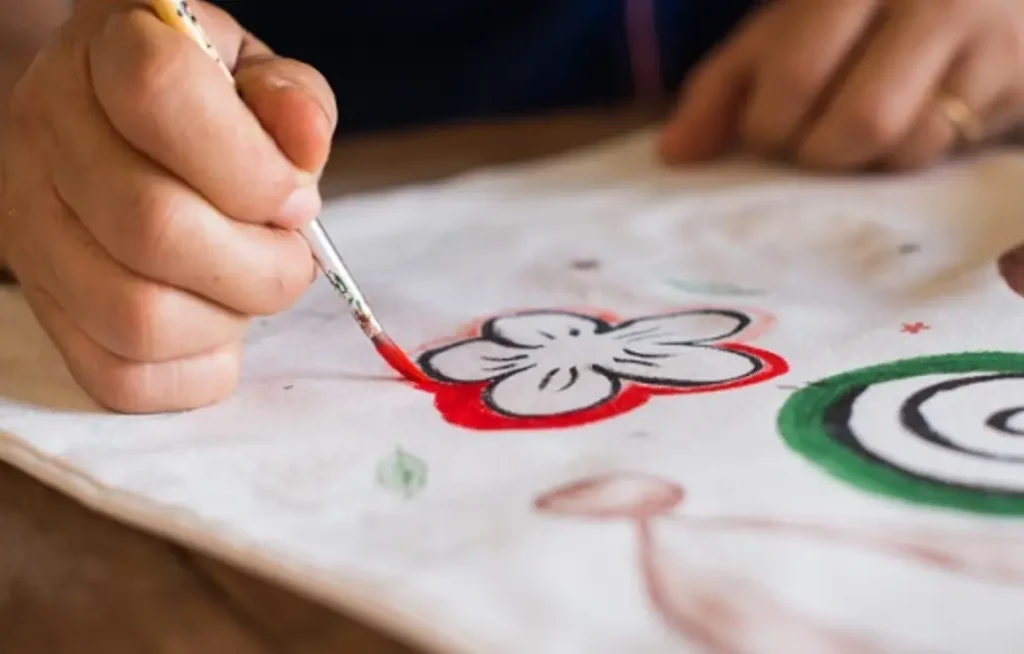Painting on canvas fabric offers a versatile and creative outlet, allowing for the transformation of plain textiles into unique works of art or personalized items. Whether you’re customizing apparel, creating decorative pieces, or producing fine art, understanding the proper techniques and materials is crucial for achieving vibrant, lasting results.
This guide provides a comprehensive overview of how to paint on canvas fabric, covering everything from preparation and paint selection to application and setting. By following these steps, you can confidently bring your artistic visions to life, ensuring your painted canvas projects are both beautiful and durable.
Canvas Fabric for Painting

Canvas fabric is a quintessential surface for painting, offering a versatile and durable support for various artistic mediums. Its unique texture and ability to hold paint make it a favorite among artists of all levels. From fine art to large-scale murals, canvas provides a stable and reliable surface that enhances the vibrancy and longevity of artwork. The choice of canvas type, whether cotton, linen, or a blend, can significantly impact the final result.
Different types of canvas offer varying textures and qualities. Cotton canvas, for instance, is a more affordable option, providing a smooth surface suitable for acrylic and oil paints. Linen canvas, on the other hand, is prized for its strength and natural texture, often preferred by professional artists for its superior quality. Primed canvas, treated with gesso, offers a ready-to-use surface that prevents paint absorption and ensures vibrant colors. Unprimed canvas allows for greater control over the painting process, but requires preparation.
How to Paint Canvas Fabric

Painting on canvas fabric offers a versatile medium for artistic expression, whether for creating art, customizing apparel, or designing home decor. Proper preparation and technique are crucial for achieving vibrant, long-lasting results.
1. Prepare the Canvas Fabric
Begin by cleaning the canvas to remove any dust or debris that could interfere with paint adhesion. If the canvas is raw, consider priming it with gesso or a fabric medium. Priming creates a smooth surface and prevents the paint from soaking into the fabric, which can lead to uneven coverage and fading. Allow the primer to dry completely before painting.
For fabrics that will be washed, pre-wash the canvas to prevent shrinkage after painting. If stretching the canvas over a frame, ensure it’s taut and secure. This provides a stable surface for painting and prevents the fabric from moving or wrinkling. Consider using masking tape to create clean edges or sections if needed.
2. Select the Right Paints and Tools
Choose paints suitable for canvas fabric. Acrylic paints are popular due to their flexibility, durability, and quick-drying properties. Fabric paints are specifically designed for textiles, offering excellent adhesion and washability. Oil paints can also be used, but they require longer drying times and may need a special primer.
Select brushes that match the desired effect. Synthetic brushes are versatile and work well with acrylics, while natural bristles are preferred for oils. Use a palette or mixing surface to blend colors. Consider using sponges, rollers, or spray bottles for different textures and effects. Protect your work surface with a drop cloth or newspaper.
3. Apply the Paint
Apply the paint in thin, even layers to avoid stiffness and cracking, especially on wearable items. For detailed work, use fine brushes and steady strokes. Allow each layer to dry before applying the next. If using stencils or masking tape, ensure they are securely adhered to prevent paint bleeding.
For larger areas, use broader brushes or rollers to achieve smooth coverage. Experiment with different techniques, such as layering, blending, and dry brushing, to create depth and texture. If painting on clothing, consider using a fabric medium to improve paint adhesion and flexibility.
4. Set and Protect the Paint
Once the painting is complete and dry, set the paint to ensure its longevity and washability. For acrylics and fabric paints, heat-setting with an iron on a low setting or using a heat gun can improve adherence. Place a cloth between the iron and the painted surface to prevent damage.
For oil paints, allow the paint to cure for several weeks before applying a protective varnish. This will seal the paint and protect it from environmental damage. For wearable items, follow the paint manufacturer’s instructions for washing and care. Consider using a fabric sealant spray to enhance durability.
Best Paint for Canvas Fabric

What paint to use on canvas fabric?
Selecting the best paint for canvas fabric is crucial for achieving vibrant, long-lasting results. The ideal paint should adhere well to the fabric, maintain its flexibility, and withstand washing or environmental exposure, depending on the project’s intended use. Acrylic paints are a popular choice due to their versatility and durability, offering excellent adhesion and quick-drying properties. Fabric paints, specifically designed for textiles, provide superior washability and flexibility, making them suitable for wearable items.
When choosing canvas paint, consider the specific requirements of your project. For artwork or decorative items, acrylic paints offer a wide range of colors and finishes, allowing for diverse artistic expression. However, for clothing or items that will be washed frequently, fabric paints are essential to prevent fading and cracking. The fabric’s texture and weave also play a role in paint selection; heavier canvases may require thicker paints or multiple layers for optimal coverage.
Best for fine art applications on stretched canvas.
Acrylic Paints:
- Versatile and widely available.
- Dries quickly and forms a durable film.
- Excellent adhesion to canvas.
- Suitable for artwork and decorative items.
- Available in various finishes (matte, gloss, satin).
Fabric Paints:
- Specifically designed for textiles.
- Superior washability and flexibility.
- Prevents fading and cracking on wearable items.
- Maintains fabric’s softness and drape.
- Requires heat-setting for optimal durability.
Oil Paints:
- Rich, vibrant colors with a long working time.
- Creates depth and texture on canvas.
- Requires longer drying and curing times.
- May need a special primer for fabric.
Types of Canvas Fabric for Painting

When selecting canvas fabric for painting, understanding the different types available is crucial for achieving the desired artistic outcome. Each canvas type offers unique characteristics that influence paint adhesion, texture, and overall durability. Here’s a breakdown of common canvas fabrics used in painting:
Cotton Canvas Fabric
Cotton canvas is a popular and affordable option, widely used by artists of all levels. It’s known for its versatility and ability to accept various paint types, including acrylics and oils. Cotton canvas offers a good “tooth,” or texture, which allows paint to adhere well. However, it can be more absorbent than linen, requiring thorough priming to prevent paint from soaking through.
Linen Canvas Fabric
Linen canvas is a premium choice, favored by many professional artists for its archival quality and durability. Made from flax fibers, linen canvas is stronger than cotton and less prone to stretching or warping over time. It offers a distinct, natural texture that enhances the richness of oil paints. While more expensive than cotton, linen canvas provides a superior surface for fine art.
Synthetic Canvas Fabric
Synthetic canvas, often made from polyester or other synthetic fibers, offers unique advantages, particularly for outdoor or large-scale projects. It’s highly resistant to moisture, mold, and UV damage, making it suitable for environments where natural canvases may deteriorate. Synthetic canvas also tends to be more affordable than linen and provides a smooth, consistent surface.
Duck Canvas Fabric
Duck canvas refers to a heavier, more tightly woven variety of cotton canvas. It is known for its ruggedness. This makes it a popular choice for artists who work on large scale projects, or who work with heavy applications of paint. The tight weave provides a very stable painting surface.
When choosing a canvas, consider your painting style, the type of paint you’ll be using, and the desired longevity of your artwork.
Can You Use Acrylic Paint on Canvas Fabric?
Yes, you can use acrylic paint on canvas fabric. Acrylic paints are versatile and adhere well to canvas, making them a popular choice for artists and crafters. They dry quickly, form a durable film, and offer a wide range of colors and finishes. However, for wearable items or fabrics that will be washed, fabric paints are generally recommended over standard acrylics due to their superior flexibility and washability.
Does Fabric Paint Work on Canvas?
Yes, fabric paint works exceptionally well on canvas. Fabric paints are specifically formulated to adhere to textiles, including canvas, and maintain flexibility after drying. This ensures that the paint doesn’t crack or peel, especially on items that will be washed or subjected to movement. They provide excellent color retention and are designed to withstand the rigors of textile use, making them ideal for customizing clothing, bags, and other canvas-based projects.
Can You Spray Paint Canvas Fabric?
Yes, you can spray paint canvas fabric, and it can be an effective technique for achieving certain effects, particularly for large-scale projects or when a smooth, even finish is desired. However, it’s essential to use spray paints designed for fabric or those that adhere well to porous surfaces. Ensure proper ventilation and protect surrounding areas, as spray paint can create overspray. Additionally, consider the fabric’s flexibility, as some spray paints can make the canvas stiff. Pre-testing on a scrap piece is always recommended to ensure the desired outcome.
Conclusion
Painting on canvas fabric unlocks a world of creative possibilities, from personalized apparel to stunning artwork. Proper preparation, including priming and stretching, ensures a stable surface for vibrant, long-lasting results. Selecting the right paints and tools, like acrylics or fabric paints, is crucial for achieving desired textures and effects.
Applying thin, even layers and setting the paint with heat or varnish enhances durability, especially for wearable items. Experimenting with techniques like layering and blending allows for unique artistic expressions. Protecting your work surface and following care instructions ensures the longevity of your painted creations.
Whether you’re an artist, DIY enthusiast, or fashion designer, mastering canvas fabric painting expands your creative repertoire. For high-quality, customizable wholesale canvas fabric that meets all your artistic needs, contact Fanda Fabrics. We offer a wide range of canvas materials and finishes to support your creative vision. Get a quote today and bring your artistic ideas to life with our premium fabrics.
